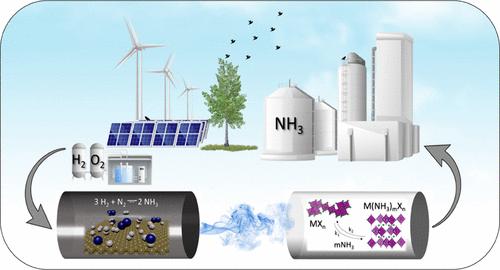当前位置:
X-MOL 学术
›
ACS Sustain. Chem. Eng.
›
论文详情
Our official English website, www.x-mol.net, welcomes your
feedback! (Note: you will need to create a separate account there.)
Catalytic Reactor-Utilized Ammonia Adsorption, Absorption, and Storage Materials: Mechanism, Nanostructure, and Ab Initio Design
ACS Sustainable Chemistry & Engineering ( IF 7.1 ) Pub Date : 2024-11-19 , DOI: 10.1021/acssuschemeng.4c06100 Aleksandra Zamljen, Blaž Likozar
ACS Sustainable Chemistry & Engineering ( IF 7.1 ) Pub Date : 2024-11-19 , DOI: 10.1021/acssuschemeng.4c06100 Aleksandra Zamljen, Blaž Likozar

|
As the world’s technological development shifts toward a sustainable energy future by harnessing renewable energy sources, ammonia is gaining recognition as a complementary green vector to hydrogen. This energy-dense carbon-neutral fuel is capable of overcoming hydrogen’s limitations in terms of storage, distribution, and infrastructure deployment. The biggest challenge to the global use of ammonia as an energy storage medium remains more efficient, readily deployable production of ammonia from abundant, yet intermittent, sources. Green decentralized ammonia production, which refers to the small-scale, localized ammonia production utilizing environmentally sustainable methods, offers a promising approach to overcoming the challenges of traditional ammonia synthesis. The process aims to minimize carbon emissions, increase energy efficiency, and improve accessibility to ammonia in remote regions. Ammonia separation using sorbent materials holds significant potential in green ammonia production, providing a viable alternative to conventional condensation-based separation methods, with particular benefits in improving energy efficiency. This perspective summarizes recent developments in the field of ammonia separation, focusing on newly developed sorbents for the integrated ammonia synthesis–separation process, particularly metal halides that could potentially replace a conventional ammonia condenser. The challenges and potential solutions are also discussed. Moreover, this perspective outlines the mechanism of ammonia absorption into metal halides with its kinetics and thermodynamics. The use of computational methods for the development of new materials is also described, thereby laying the foundations of green ammonia technology.
中文翻译:

催化反应器利用氨的吸附、吸收和储存材料:机理、纳米结构和 Ab Initio 设计
随着世界技术发展通过利用可再生能源转向可持续能源的未来,氨作为氢的补充绿色载体越来越受到认可。这种能量密集的碳中和燃料能够克服氢气在储存、分配和基础设施部署方面的限制。全球使用氨作为储能介质的最大挑战仍然是从丰富但间歇性的来源更高效、易于部署的氨生产。绿色分散式氨生产是指利用环境可持续方法进行小规模、局部的氨生产,为克服传统氨合成的挑战提供了一种很有前途的方法。该工艺旨在最大限度地减少碳排放、提高能源效率并改善偏远地区对氨的可及性。使用吸附剂材料进行氨分离在绿氨生产中具有巨大潜力,为传统的基于冷凝的分离方法提供了可行的替代方案,在提高能源效率方面具有特别的好处。本观点总结了氨分离领域的最新发展,重点介绍了新开发的用于合成-合成-分离过程的吸附剂,特别是可能取代传统氨冷凝器的金属卤化物。还讨论了挑战和潜在的解决方案。此外,该观点概述了氨吸收成金属卤化物的机制及其动力学和热力学。还描述了使用计算方法开发新材料,从而为绿氨技术奠定了基础。
更新日期:2024-11-19
中文翻译:

催化反应器利用氨的吸附、吸收和储存材料:机理、纳米结构和 Ab Initio 设计
随着世界技术发展通过利用可再生能源转向可持续能源的未来,氨作为氢的补充绿色载体越来越受到认可。这种能量密集的碳中和燃料能够克服氢气在储存、分配和基础设施部署方面的限制。全球使用氨作为储能介质的最大挑战仍然是从丰富但间歇性的来源更高效、易于部署的氨生产。绿色分散式氨生产是指利用环境可持续方法进行小规模、局部的氨生产,为克服传统氨合成的挑战提供了一种很有前途的方法。该工艺旨在最大限度地减少碳排放、提高能源效率并改善偏远地区对氨的可及性。使用吸附剂材料进行氨分离在绿氨生产中具有巨大潜力,为传统的基于冷凝的分离方法提供了可行的替代方案,在提高能源效率方面具有特别的好处。本观点总结了氨分离领域的最新发展,重点介绍了新开发的用于合成-合成-分离过程的吸附剂,特别是可能取代传统氨冷凝器的金属卤化物。还讨论了挑战和潜在的解决方案。此外,该观点概述了氨吸收成金属卤化物的机制及其动力学和热力学。还描述了使用计算方法开发新材料,从而为绿氨技术奠定了基础。


















































 京公网安备 11010802027423号
京公网安备 11010802027423号